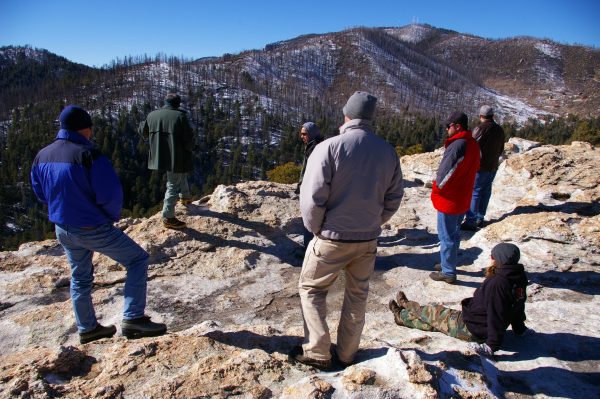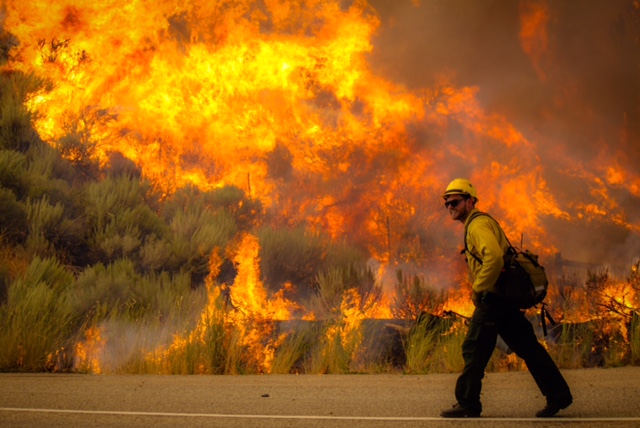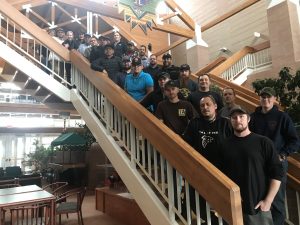April 5, 2019
Every year, dozens of firefighters and land managers for various federal agencies come to Northern Arizona University for class. Most have years of experience fighting fires or managing forests before and after fires. They know a lot about the forests, woodlands, chaparral, high deserts and grassland because of their careers, but they don’t have much in the way of classroom experience when it comes to plant communities and fire ecology.
That might not seem important, but students are walking out with tangible knowledge that they can apply to their jobs. Halfway through courses, they’re creating programs to better monitor the forests they manage to help reduce the long-term damage of fire. What they learn in the classroom directly correlates with the work they do each day, and their work in the field is more effective and targeted with the knowledge they bring from the classroom.
This coursework, the Fire Ecology and Management Certificate for Professionals, or 401 program, started more than a decade ago at the request of the U.S. Forest Service, which wanted employees to have a certain level of relevant education to be promoted past a certain point. At the time, with the Forest Service’s encouragement, a number of universities started similar programs.
Over time, the 401 program became less of a priority for the Forest Service, and many programs throughout the United States ended. NAU also was in danger of losing the 401 program, said James Allen, executive director of the School of Forestry, but Bureau of Indian Affairs (BIA) administrators heard about it and began sending their people to NAU’s program. Employees of other federal agencies, including the Fish and Wildlife Service, the Bureau of Land Management and the National Park Service, attended. NAU’s program is now one of two left in the nation and the only one with an in-class component.
“BIA has basically made us their program for the nation that they send their people to,” said Andi Thode, a professor of forestry and director of the program.
It’s kept going, with students from all over the country taking online courses and coming to NAU a week at a time, to earn a 24-hour certificate that will enable them to be promoted from the technician series to the professional, or 401 series. Without this coursework, fire managers cannot move into the professional series, which allows them to qualify for much higher-level jobs in the federal agencies. But the 401 faculty members at NAU make sure these courses aren’t just a task to be checked off. They carefully plan the curriculum, including field trips, time in the computer lab and networking with other land managers, to ensure students leave with information they can apply to their jobs.
The topics discussed in the course remain critical to the question of wildland and wildfire management, Allen said. California’s record-setting fire seasons have made that clear.
“This problem isn’t going away,” he said. “It’s going to get worse before it gets better. Climate does seem to be changing, the scale is increasing, and there are increasing challenges in places like California where people are moving into the wildland-urban interface and into fire-prone ecosystems.”
 The students
The students
Margaret Moore teaches the FOR 310 course, Forest Ecology for Professionals. For most students, it’s the introductory course of the program. In her fall 2018 course, one of Moore’s students was involved in knocking down the Camp Fire, which destroyed the city of Paradise, California, and killed 85 people; two others fought the Woolsey Fire, the worst wildfire in Los Angeles County’s history. A former student died fighting the Ferguson Fire in Yosemite National Park last summer.
“Most of the students are professionals with families and kids; they’re balancing many things in their lives, in addition to working in very extreme and dangerous conditions on a daily basis,” Moore said. “Some of their stories are very touching, and in some cases heartbreaking. This is the real story behind the 401 series of course. Their desire to advance their education has changed me as a teacher.”
Thode, who no longer teaches but still regularly interacts with students, said the 401 classes have a different feel to them. She’s careful to not push students to move through the program too quickly; on top of jobs and families, many are coming to school for the first time in years or for the first time in higher education at all.
“You have to learn how to learn,” Thode said. “It’s a skill to know how to read a textbook.”
But, the faculty members said, it rarely takes long for classes and students to move forward. So often, that comes as students take what they learn in class and figure out how to apply it to a project they’re working on or a forestry problem they can’t just figure out how to solve. Lightbulbs start going off, Thode said.
“The people that come into these classes, they’re really driven to be here,” she said. “They’re not always the best students, because they haven’t been in school for a while or never experienced college, but they work so hard and they get really excited about the classes. They were some of my favorite students.”
One of those students in 2019 is Brad Bryant, an engine captain from the BLM who is based in Vernal. He needs the courses to be 401-certified, but he’s seen the benefits of connecting coursework with fieldwork. And federal agencies who are hiring know when they see NAU as the source of this education that the student has a solid knowledge base. These classes are a worthwhile investment, he said.
“I have more ground-based experience,” he said. “It just makes a bigger picture come together as to why we’re doing what we’re doing.”
He likes that NAU’s program has a classroom element. The other options available are all online, and a good chunk of NAU’s is as well, but every course brings the cohort to NAU for face time with each other and professors, which allows for better learning.
Students in the 401 series often comment about how they’ve seen different phenomena as they’ve managed land or worked to control fires, but they didn’t always know what those events meant until they learned about them in class. That changes the tenor of the classroom, Thode said. Everything the students learn, they can put into the appropriate context.
“This is truly making a difference in terms of credentialing them and moving them up supervisory ranks,” Allen said. “We see this as a great program serving the forestry community in the Southwest and nationally and making a positive difference in the lives of quite a few.”
Curriculum
Courses cover fire ecology and biology, ecology and environmental sciences, fire and fuels management, measurement analysis and technology and

fire management and policy. Students learn to run computer simulations and create monitoring programs, which they can use in their day-to-day fire management work.
The whole point, Thode said, is to really prepare land managers for the next step, not just to check an education box on a job application.
As an example, she pointed to Alan Sinclair, who was a type III engine captain with the Forest Service when he started the program in 2007. In 2008, he accepted a job as a fire management officer with the BIA and finished the 401 program in 2009 as a requirement of his new job. After learning about forest monitoring, he started a program at work. In the process of researching these programs, he got in touch with fire managers from Germany, and in the last decade has gone to Germany a few times to advise their programs. He even deployed with the German firefighters to Portugal, where he provided oversight as the crew fought fires with Portuguese volunteer fire departments.
As he rose through the ranks, he sent his employees to NAU’s 401 program. Now he’s a type I incident commander who recently told Thode that he has applied everything he learned in those courses to his work today.
Forest monitoring is a big part of their jobs and this education, Thode said. Many of these agencies take steps to control wildfire and mitigate the severe negative effects, but they don’t have the resources to monitor how effective those efforts are. In their classes, students and professors talk about ways to monitor that fit into limited time and finances.
“If you understand what you’re doing, you’re revisiting areas that you’ve burned to look at the effects, then you can emulate those effects in the future with similar types of management applications and similar types of fire,” Thode said.
“They learn ways to understand what those practices actually do on the ground,” Thode said. “This is really where management and science hit the road together.”
This relationship between wildlands and fire is especially important in the Southwest, where fire is a normal part of the ecosystem. No land manager is trying to stop wildfires; they’re trying to manage the vegetation so when fires start the ecosystem survives and recovers.
“It’s not if fire hits a landscape, it’s when fire hits it and how it hits it,” she said. “There has been a big shift in perspective and in the culture in land management agencies that allow more use of fire to benefit the landscape.”
[accordion]
Hear from an NAU grad about the importance of fire ecology education
Leon Ben, a 1994 graduate of the NAU School of Forestry and a Bureau of Indian Affairs branch chief for wildland fire management, sends as many employees as he can to the complete the 401 series. He talked to NAU News about the importance of the program for the work his department does.
Why have you supported the program through the years?
I’ve always encouraged people I work with to earn a higher level of education beyond high school, and I am particularly supportive of all university programs that can help our fire technicians develop their professional careers. NAU is one university that offers a specialized certificate program that benefits wildland firefighters interested in pursuing a professional career in wildland fire management. There are other universities, such as the University of Idaho, that also offer a certificate program similar to NAU’s.
NAU School of Forestry’s Fire Ecology and Management Certificate program is a local program for many Bureau of Indian Affairs (BIA) and tribal wildland fire programs in Western Region. The Western Region encompasses Arizona (except the Navajo Nation), Utah, Nevada and parts of California, Oregon and Idaho. For Indian Country, especially tribes in the Southwest, supporting NAU really means we are supporting employees who have a desire to become future fire management leaders.
Why is this program valuable?
Those who earn the certificate are more knowledgeable and have a better understanding of the role fire has in the ecosystem. Since 2009, Western Region has sent 19 BIA and tribal fire management employees through the Fire Ecology and Management Certificate program at NAU. Over the years, we have seen a return on investment as these employees are now competing for and filling key fire management leadership positions and helping to mentor the next generation of students who are also wildland firefighters.
How have you seen your employees benefit from this?
Earning college credits opens doors for everyone. For fire technicians, once they earn a Fire Ecology and Management Certificate, they are able to move beyond the technician series and qualify for professional series jobs. These are higher-graded positions that afford greater pay and benefits over the course of their careers.
I also see an increase in confidence and morale from those who have worked hard to earn their certificates. This affects the whole program as we are able to mentor employees who persevered to earn a difficult certificate. They in turn become advocates of earning similar certificates.
How has your NAU education has benefitted you in the field?
I earned a bachelor of science degree in forest management in 1994. Over the years, this degree allowed me to qualify for higher management positions. Shortly after graduation, I went to work for the San Carlos Apache Tribe as a woodland forester, which led to becoming the tribe’s fire management coordinator. I stayed in that position for two years before taking a position at the BIA Western Regional Office as an assistant regional fire management officer. Fast-forward 20 years, I now lead the Bureau of Indian Affairs Wildland Fire Management Program as the branch chief for wildland fire management.
My degree in forestry provided me the foundational skills necessary for evaluating complex data, writing comprehensive reports and ultimately understanding the science of the landscapes. It also taught me critical interpersonal skills I’ve relied on to communicate and work in a dynamic and complex environment.
[/accordion]
[accordion]
Read about how these courses fit into NAU’s strategic plan
Thode and Allen both highlighted how this program fits into almost every facet of NAU’s strategic plan:
- Student success and access: The program provides access to education that otherwise would be difficult for these students to get, including face time with instructors and building relationships with each other. These courses also qualify students for higher-level positions in their agencies.
- Commitment to Native Americans: The 401 series is a partnership with the Bureau of Indian Affairs, and about two-thirds of the students are from underrepresented minority groups, including a large percentage of Native American students.
- Engagement: Students from all over the country come to NAU for this program, and past students come to the School of Forestry to recruit NAU students to their agencies, to work with faculty members on management questions and research and collaborate with the Southwest Fire Science Consortium to improve relationships between scientists and land managers. Alumni from this program also come speak to forestry and land management classes and work with the Student Association for Fire Ecology.
- Stewardship: This series provides a steady revenue stream while also providing a varied, practical education in a flexible way to serve fire professionals who cannot get this certification anywhere else. Approximately 600 people have taken the course in the last 12 years; in the 2017-18 academic year, the 401 program brought in almost $120,000 in tuition revenue for 88 students.
[/accordion]

(928) 523-8737 | heidi.toth@nau.edu




